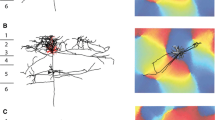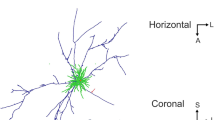The distribution of callosal neurons in the cortical layers was studied in intact (n = 7) and experimental cats with strabismus (n = 10) or monocular deprivation (n = 5) after microiontophoretic administration of horseradish peroxidase into the eye dominance columns of fields 17 and 18 and the fields 17/18 transitional zone. Callosal neurons in cats with impairments to binocular vision were located more deeply in layers II/III and more shallowly in layer IV than in intact cats. In addition, the proportion of callosal neurons in layer IV increased and the proportion in layer II/III decreased in cats with impaired binocular vision, as compared with intact cats, and these changes were more marked in monocular deprivation. These data point to the important role of sensory information in the formation of the laminar distribution of callosal neurons.
Similar content being viewed by others
References
S. V. Alekseenko, P. Yu. Shkorbatova, and S. N. Toporova, “Effects of strabismus and monocular deprivation on the sizes of callosal cells in fields 17 and 18 of the cat cortex,” Ros. Fiziol. Zh., 98, No. 4, 479–487 (2012).
S. V. Alekseenko, P. Yu. Shkorbatova, S. N. Toporova, and S. D. Solnushkin, “Effects of strabismus and monocular deprivation on the structure of interhemisphere connections in the projection visual fields of the cat cortex,” Sensor. Sist., 26, No. 2, 106–116 (2012).
P. Yu. Shkorbatova, S. N. Toporova, F. N. Makarov, and S. V. Alekseenko, “Intracortical connections of eye dominance columns infields 17 and 18 in experimental strabismus in cats,” Sensor. Sist., 20, No. 4, 309–318 (2006).
N. E. Berman and S. Grant, “Topographic organization, number, and laminar distribution of callosal cells connecting visual cortical areas 17 and 18 of normally pigmented and Siamese cats,” Vis. Neurosci., 9, No. 1, 1–19 (1992).
E. Bui Quoc, J. Ribot, N. Quenech’Du, et al., “Asymmetrical interhemispheric connections develop in cat visual cortex after early unilateral convergent strabismus: anatomy, physiology, and mechanisms,” Front. Neuroanat., 5, 1–129 (2012).
E. M. Callaway and V. Borrell, “Developmental sculpting of dendritic morphology of layer 4 neurons in visual cortex: influence of retinal input,” J. Neurosci., 31, No. 20, 7456–7470 (2011).
D. H. Hubel and T. N. Wiesel, Brain and Visual Perception: the Story of a 25-Year Collaboration, Oxford University Press, New York (2005).
G. M. Innocenti, D. Aggoun-Zouaoui, and P. Lehmann, “Cellular aspects of callosal connections and their development,” Neuropsychologia, 33, No. 8, 961–987 (1995).
L. Kiorpes, D. C. Kiper, L. P. O’Keefe, et al., “Neuronal correlates of amblyopia in the visual cortex of macaque monkeys with experimental strabismus and anisometropia,” J. Neurosci., 18, 6411–6424(1998).
J. A. Matsubara, R. Chase, and M. Thejomaven, “Comparative morphology of three types of projection-identified pyramidal neurons in the superficial layers of cat visual cortex,” J. Comp. Neurol., 366, 93–108 (1996).
B. R. Ayne and A. Peters, “The Concept of Cat Primary Visual Cortex,” in: The Cat Primary Visual Cortex, Academic Press, San Diego (2002), pp. 1–29.
K. J. Sanderson, “The projection of the visual field to the lateral geniculate and medial lateral nuclei in the cat,” J. Comp. Neurol., 143, No. 1, 101–117 (1971).
M. A. Segraves and A. C. Rosenquist, “The distribution of the cells of origin of callosal projections in cat visual cortex,” J. Neurosci., 2, No. 8, 1079–1089 (1982).
C. J. Shatz and M. B. Luskin, “The relationship between the geniculocortical afferents and their cortical target cells during development of the cat’s primary visual cortex,” J. Neurosci., 6, No. 12, 3655–3668 (1986).
R. J. Tusa, L. A. Palmer, and A. C. Rosenquist, “Multiple cortical areas: Visual field topography in the cat,” in: Cortical Sensory Organization, Humana Press, New York (1981), Vol. 2, pp, 1–31.
A. Vercelli, F. Assal, and G. M. Innocenti, “Emergence of callosally projecting neurons with stellate morphology in the visual cortex of the kitten,” Exp. Brain Res., 90, No. 2, 346–358 (1992).
Author information
Authors and Affiliations
Corresponding author
Additional information
Translated from Morfologiya, Vol. 147, No. 2, pp. 12–16, March–April, 2015.
(S. N. Toporova) Deceased.
Rights and permissions
About this article
Cite this article
Toporova, S.N., Shkorbatova, P.Y. & Alekseenko, S.V. Layerwise Organization of Neurons Providing Interhemisphere Connections in the Visual Cortex of Cats with Impaired Binocular Vision. Neurosci Behav Physi 46, 219–223 (2016). https://doi.org/10.1007/s11055-015-0221-6
Received:
Published:
Issue Date:
DOI: https://doi.org/10.1007/s11055-015-0221-6




